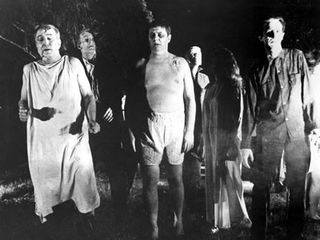Fear
Why We Fear the Zombie Apocalypse
Why do zombies occupy such a special niche in the universe of horror?
Posted October 11, 2018

ZOMBIE. The very word can send shivers down your spine. Is it dead - or not? Is it human - or not? There is no other Hollywood paragon of horror that can approach the fundamental creepiness of the zombie.
So what is behind our preoccupation with them? Why do zombies occupy such a special niche in the universe of horror?
The first zombie movie, White Zombie, appeared in 1932 and it was followed by a smattering of forgettable zombie films throughout the 1940s and 1950s. It was not until the release of George Romero’s Night of the Living Dead in 1968 that the tsunami of zombie-centric entertainment that continues to wash over us was ignited. Since then, there have been over 500 zombie feature films, ranging from light-hearted spoofs of the genre such as Shaun of the Dead to truly terrifying renditions such as The Dawn of the Dead that inspired it. Zombies have been celebrated in Michael Jackson’s Thriller video, and The Walking Dead (currently in its ninth season) remains one of television’s most popular shows.
The History of Zombies

The modern notion of what a zombie is can be traced to the Haitian Voodoo folklore of the 17th and 18th centuries. At that time, it was rumored that African slaves on sugar plantations who committed suicide to escape their miserable existence were denied entry into eternal paradise, and were condemned instead to trudge around the Earth without a soul. Over time, this legend morphed into the Voodoo belief that priests (called Bokors) had the power to turn people into zombies. The unfortunate individual chosen as a zombie-to-be would be poisoned by the Bokor, causing vital signs such as heartbeat and breathing to diminish to the point where the individual appeared to be dead. Consequently, the person would be buried alive. That individual was later exhumed by the Bokor, and he or she would then remain under his spell forever. To add insult to injury, the person was usually brought back to life without the benefit of speech or free will.
The word “zombie” comes from the Kongo word “nzambi” by way of the Creole word “zonbi” -- both words refer to a dead person who has been brought back to life. Current monikers for zombies such as “the undead” or “the living dead” have managed to remain true to this original meaning.
It is in the Uncanny Valley that Creepy Things Reside
My research on creepiness has explored why certain people and places creep us out. The short version of what I have found is that it is an ambiguity about whether we have something to fear from a person or a place that makes us uncomfortable because the uncertainty leaves us at a loss for knowing how to respond.
However, philosopher David Livingstone Smith believes that the potential for danger is not always necessary for something to appear creepy. He proposed a “Categorical Ambiguity Thesis” to explain how we can be creeped-out by something that almost certainly poses no real threat to us. According to Smith, objects that are not easily categorized combine features that do not usually occur together -- and this makes us uneasy because we cannot properly make sense of them, resulting in a cognitive paralysis that we find unpleasant. Smith’s hypothesis is closely related to the concept of the uncanny valley.
The Uncanny Valley is well known in the field of aesthetics, and it was pioneered by Masahiro Mori, a Japanese Professor of robotics. As an inanimate object comes to look and act more like an actual human being, it usually becomes more attractive to us. That is, until it becomes almost exactly like a human – but not quite. Things that reach this level of proximity to humanness often prompt feelings of revulsion rather than attraction. The uncanny valley refers to this narrow band between “cute but not human” and “fully human.” In other words, things that cause us to react to them as if they are human, even when we know that they are not human, creep us out. The fact that mannequins, ventriloquist dummies, and creepy life-like dolls frequently show up in horror films is no accident.
The uncanny valley can explain our squeamishness about corpses -- just like a normal human, except not alive – as well as the fascination that we have with zombies. Unlike many of the other monsters that haunt our imaginations, zombies were once normal human beings. A traumatic event, usually being bitten by a zombie, has somehow transformed them into something eerily human and dangerously not human. Zombies may even maintain their identity as the distinct individual humans that they were in their previous life, making them all the more creepy and sinister.
In other words, zombies combine the worst of both worlds: they are a clear and unambiguous threat of the worst kind of harm imaginable, so they fill us with horror. On top of that, their “almost human” quality creates a sense of revulsion and dread, so they both creep us out and terrify us at the same time! It is no wonder that they have been the stuff of nightmares for many centuries and that they are the creepiest of all the monsters we have imagined.
And so, if anything gets us all in the end, I think it will most likely be the zombies. After all, no one is preparing for a “ghost apocalypse” or a “werewolf apocalypse.”




